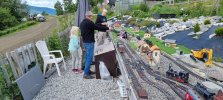Marcelvandervelpen
Registered
Hi,
I run a garden railway in Norway. All my locomotives are analogue, no decoders. Locomotives with double tractionmotors have no problem with negotiating poor contact from the tracks. Single motor locomotives however do have this problem. Where contact with he tracks is poor, or on points, some of them don't run smoothly. I thought adding a 2200 uF cap would do the trick, but no.
Apart from keeping the tracks clean, is there any way I can give my locomotives this extra push when they need it?
I run my installation from two 12 V 87 Ah batteries in series (24V) through some electronics to simulate brake and inertia effect.
I have some old school books with some DIY circuitry to supply the tracks/ loco's with PWM, but I'm afraid this will kill the motors (heating up)
Any suggestions from you other analogue folks?
I run a garden railway in Norway. All my locomotives are analogue, no decoders. Locomotives with double tractionmotors have no problem with negotiating poor contact from the tracks. Single motor locomotives however do have this problem. Where contact with he tracks is poor, or on points, some of them don't run smoothly. I thought adding a 2200 uF cap would do the trick, but no.
Apart from keeping the tracks clean, is there any way I can give my locomotives this extra push when they need it?
I run my installation from two 12 V 87 Ah batteries in series (24V) through some electronics to simulate brake and inertia effect.
I have some old school books with some DIY circuitry to supply the tracks/ loco's with PWM, but I'm afraid this will kill the motors (heating up)
Any suggestions from you other analogue folks?

